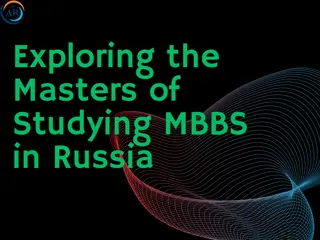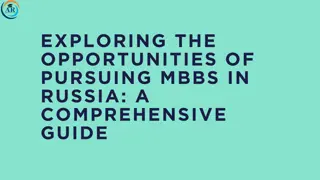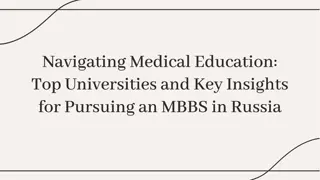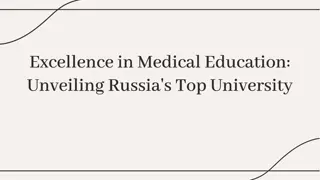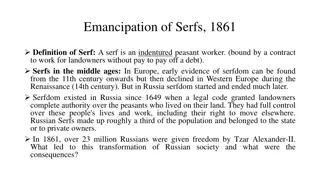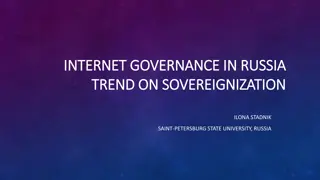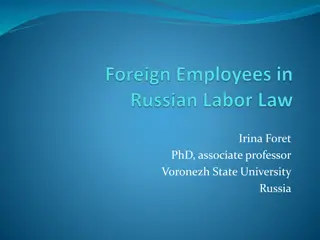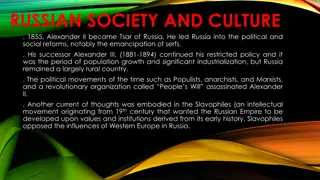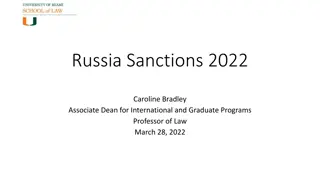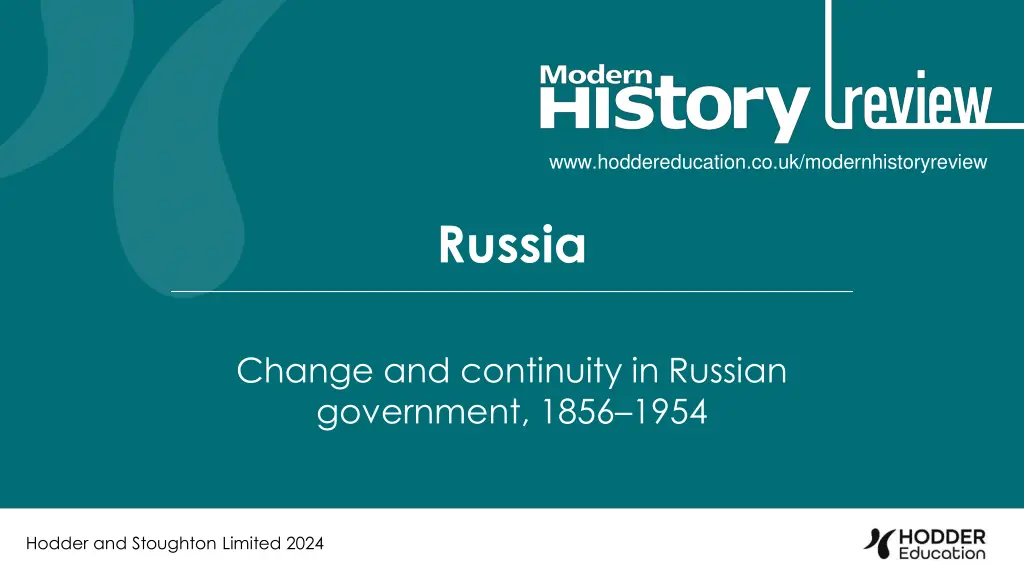
Change and Continuity in Russian Government: 1856-1954 Overview
Explore the evolution of Russian government from 1856 to 1954, focusing on ideology, central government, local government, and repression. Delve into shifts in autocracy, democracy, dictatorship, and totalitarianism, and uncover similarities and differences between tsars and Communist rulers. Trace changes in central government structures under Nicholas II, the Provisional Government, and Stalin's regime.
Download Presentation

Please find below an Image/Link to download the presentation.
The content on the website is provided AS IS for your information and personal use only. It may not be sold, licensed, or shared on other websites without obtaining consent from the author. If you encounter any issues during the download, it is possible that the publisher has removed the file from their server.
You are allowed to download the files provided on this website for personal or commercial use, subject to the condition that they are used lawfully. All files are the property of their respective owners.
The content on the website is provided AS IS for your information and personal use only. It may not be sold, licensed, or shared on other websites without obtaining consent from the author.
E N D
Presentation Transcript
www.hoddereducation.co.uk/modernhistoryreview Russia Change and continuity in Russian government, 1856 1954 Hodder and Stoughton Limited 2024
Introduction This presentation considers FOUR areas of Russian government and offers suggestions of both continuity and change for each element. These elements are: ideology central government local government repression. Hodder and Stoughton Limited 2024
Ideology Change in the ideology of Russian rulers: autocracy under the Tsars democracy under provisional government dictatorship under Lenin totalitarianism under Stalin de-Stalinisation after Stalin. Hodder and Stoughton Limited 2024
Ideology What were the differences? Justification for autocratic rule from tsars based on God. Views on human nature. Views on reform. Views on representative government. Hodder and Stoughton Limited 2024
Ideology Continuity The most common view is that the Communists were seen as Red Tsars, therefore in practice little real difference. However, what were the similarities? Hodder and Stoughton Limited 2024
Ideology Similarities: Both the tsars and Communist rulers believed in absolute control and power. Personalised power: power resided with one person throughout the period. Repression was used by all rulers to maintain control and power. Hodder and Stoughton Limited 2024
Ideology Reforms were passed, but these were to maintain power. Alexander II: better reform from above than revolution from below . Neither tsar nor Communists were willing to allow openness and freedom, seen with censorship, religion. Hodder and Stoughton Limited 2024
Central government What changes were there in central government? Nicholas II published the October Manifesto. Provisional government was democratic rather than autocratic. Under Stalin, appeared to give greater representation with the 1936 Constitution. This created new representative organs. But Article 126 of the Constitution stated the Communist Party remained: the nucleus of all the public and state organisations of the working people . Hodder and Stoughton Limited 2024
Central government Changes therefore: short-lived maintained the power of the ruler (often this was disguised). Hodder and Stoughton Limited 2024
Central government What continuity was there in central government? All administration was hierarchical tsar or Politburo. Organs of government accountable to leaders, not people. Democracy was never implemented. All regimes had a variety of organs of government which performed specific jobs. Under the Tsar, Council of Ministers, Imperial Council of State, Committee of Ministers and Senate. Under Communists, All- Russian Congress of Soviets, Central Executive Committee (Politburo, Orgburo) and Sovnarkom. Hodder and Stoughton Limited 2024
Central government Both tsars and Communists showed some sign of reform, but was limited. ANY change was therefore superficial Hodder and Stoughton Limited 2024
Local government Changes in local government Under the tsars: Before 1861, provinces under jurisdiction of noble landowners. Zemstva introduced 1864 following Emancipation of Serfs. Duma introduced 1870. Land Captains under Alexander III. Hodder and Stoughton Limited 2024
Local government Under the Communists: Zemstva and Duma abolished by Communists. Under Communists, local government dominated by Soviets. Hodder and Stoughton Limited 2024
Local government Continuity? Both Tsars and Communists maintained control over the localities. Power of local councils under tsars was restricted by bringing in Land Captains, while any semblance of democracy as seen with the Duma was destroyed by the Communists, so they maintained ultimate control. Hodder and Stoughton Limited 2024
Repression Continuity All regimes used repressive measures to control the people: secret police army propaganda Censorship. Hodder and Stoughton Limited 2024
Repression Secret police Used throughout the period, although the name changed. Alexander II used Third Section to exile opponents and in 1880 Okhrana to target individuals. Alexander III and Nicholas II used Okhrana against SRs and SDs. Lenin established Cheka, implemented War Communism and Red Terror. Cheka replaced by OGPU and under Stalin NKVD, responsible for purges and show trials. Khrushchev brought in MVD and KGB. Hodder and Stoughton Limited 2024
Repression Army Used to quell unrest by tsars and Communists. Censorship Number of publications in print were controlled. What was written was controlled. Hodder and Stoughton Limited 2024
Repression All regimes use propaganda Use of pamphlets and newspapers. Use of statues. Glorify leaders under Nicholas II, celebrations for tercentenary of Romanov dynasty, under Stalin towns named after him. Hodder and Stoughton Limited 2024
Repression Change While it is agreed both tsars and Communists used repression, the Communists used more extreme measures to create a sense of terror: Red Terror. Purges and Gulags. Hodder and Stoughton Limited 2024
Repression Scale of repression of Secret police Compare numbers arrested under Alexander III with Stalin. Numbers in Gulags under Stalin and Khrushchev. Hodder and Stoughton Limited 2024
Repression Army Under tsars, used to put down strikes, Bloody Sunday, Lena Goldfields. Under Bolsheviks, used to win civil war and to administer purges. Hodder and Stoughton Limited 2024
Repression There are periods of Glasnost, not always full-scale repression: Glasnost under Alexander II and Nicholas II, but repression under Alexander III (The Reaction). Censorship much stricter under Communists, with establishment of Agitprop in 1921 and APW. Communists have official newspapers: Pravda, Izvestiya, Trud. Hodder and Stoughton Limited 2024
Repression The use of propaganda is much more evident under the Communists, who also took advantage of new forms. Communists develop the cult of personality. Communists make great use of visual material photographs are changed, paintings and film. Communists create heroes, such as Stakhanov. Hodder and Stoughton Limited 2024
Repression Repression is much more invasive under Communists, stricter control and more are persecuted/arrested. Scale and methods change under the Communists. Hodder and Stoughton Limited 2024
Conclusion All rulers ruled as types of autocrats, using both repression and reform. The difference in the personality and attitude of rulers did see some changes between rulers, but never to undermine their power. Hodder and Stoughton Limited 2024






